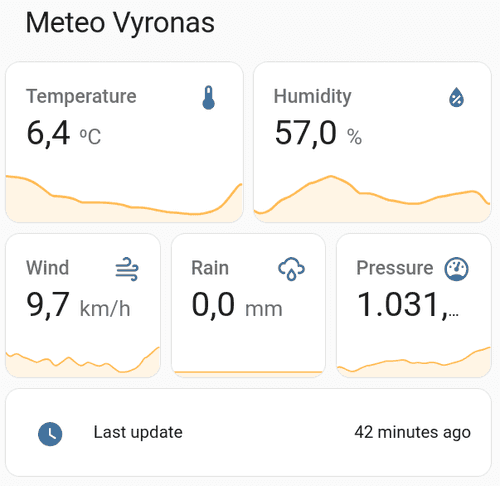Μετεωρολογικός σταθμός Αστεροσκοπείου στο Home Assistant
🇬🇷
Το παρόν άρθρο περιέχει οδηγίες για το πώς μπορούμε να προσθέσουμε τα στοιχεία ενός μετεωρολογικού σταθμού του Αστεροσκοπείου Αθηνών στο Home Assistant π.χ. για να τα εμφανίσουμε σε κάρτα στο dashboard. Ως παράδειγμα τοποθεσίας χρησιμοποιείται ο μετεωρολογικός σταθμός του Βύρωνα.
Χρησιμοποιώντας το File editor Add-on, δημιουργούμε νέο φάκελο (directory) με όνομα packages (αν δεν υπάρχει ήδη) και μέσα του δημιουργούμε νέο αρχείο με όνομα meteo_vironas.yaml και περιεχόμενο:
meteo_vironas:
scrape:
- resource: 'https://penteli.meteo.gr/stations/vyronas/'
headers:
User-Agent: 'Mozilla/5.0 (Windows NT 10.0; Win64; x64) AppleWebKit/537.36 (KHTML, like Gecko) Chrome/131.0.0.0 Safari/537.3'
scan_interval: 3600
sensor:
- name: Meteo Vironas last updated
unique_id: meteo_vironas_last_updated
select: .headline.gradient span
index: 1
value_template: '{{ (strptime(value, "%d/%m/%Y %H:%M") | as_local).isoformat() }}'
device_class: timestamp
- name: Meteo Vironas temperature
unique_id: meteo_vironas_temperature
select: .realtime .lright span
value_template: '{{ value.split(" ")[0] | float }}'
unit_of_measurement: '°C'
device_class: temperature
- name: Meteo Vironas humidity
unique_id: meteo_vironas_humidity
select: .realtime .lright span
index: 1
value_template: '{{ value.split(" ")[0] | float }}'
unit_of_measurement: '%'
device_class: humidity
- name: Meteo Vironas wind speed
unique_id: meteo_vironas_wind_speed
select: .realtime .lright span
index: 3
value_template: '{{ value.split(" ")[0] | float }}'
unit_of_measurement: 'km/h'
device_class: wind_speed
- name: Meteo Vironas barometric pressure
unique_id: meteo_vironas_barometric_pressure
select: .realtime .lright span
index: 4
value_template: '{{ value.split(" ")[0] | float }}'
unit_of_measurement: hPa
device_class: pressure
- name: Meteo Vironas rain today
unique_id: meteo_vironas_rain_today
select: .realtime .lright span
index: 5
value_template: '{{ value.split(" ")[0] | float }}'
unit_of_measurement: mm
device_class: precipitationΣτη συνέχεια, πάλι στο File editor Add-on, πηγαίνουμε ένα επίπεδο πίσω και ανοίγουμε το αρχείο configuration.yaml προσθέτοντας:
homeassistant:
packages: !include_dir_merge_named packagesΚάνουμε επανεκκίνηση στο Home Assistant.
Αυτό θα έχει ως αποτέλεσμα να δημιουργηθούν οι ακόλουθοι σένσορες:
meteo_vironas_last_updated— Ημερομηνία και ώρα τελευταίας ενημέρωσης (timestamp)meteo_vironas_temperature— Θερμοκρασία σε °C (temperature)meteo_vironas_humidity— Υγρασία σε % (humidity)meteo_vironas_wind_speed— Ταχύτητα ανέμου σε km/h (wind_speed)meteo_vironas_barometric_pressure— Βαρομετρική πίεση σε hPa (pressure)meteo_vironas_rain_today— Ύψος σημερινής βροχής σε mm (precipitation)
Ακολουθεί παράδειγμα κάρτας σε dashboard:
type: vertical-stack
cards:
- type: vertical-stack
cards:
- type: horizontal-stack
cards:
- graph: line
type: sensor
entity: sensor.meteo_vironas_temperature
detail: 2
unit: ⁰C
name: Θερμοκρασία
- graph: line
type: sensor
entity: sensor.meteo_vironas_humidity
unit: "%"
detail: 2
name: Υγρασία
- type: horizontal-stack
cards:
- graph: line
type: sensor
entity: sensor.meteo_vironas_wind_speed
detail: 2
name: Άνεμος
- graph: line
type: sensor
entity: sensor.meteo_vironas_rain_today
detail: 2
name: Βροχή
- graph: line
type: sensor
entity: sensor.meteo_vironas_barometric_pressure
detail: 2
name: Πίεση
- type: entities
entities:
- entity: sensor.meteo_vironas_last_updated
name: Τελευταία ενημέρωση
show_header_toggle: false
title: Meteo.gr ΒύρωναςΚαι το αποτέλεσμα:
